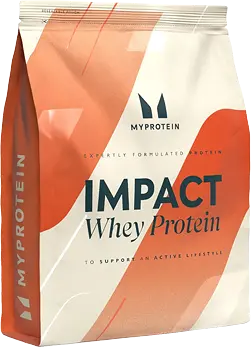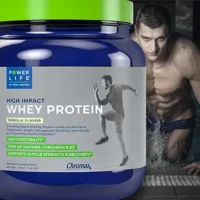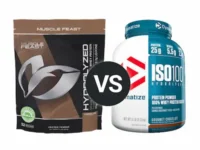Knowledge BaseYou're Questions Answered
Are all whey protein powders the same?
No, not all whey protein powders are the same. Whey protein, a by-product of cheese production, is popular among athletes and fitness enthusiasts due to its high-quality protein that efficiently supports muscle growth and repair. However, there are several different types of whey protein, each varying significantly in composition, digestion rate, and usability based on processing methods and additional ingredients.
The three main types of whey protein powders are:
Whey Protein Concentrate (WPC): WPC contains lower levels of protein by weight (around 70-80%) and includes more fats, minerals, and lactose. It is less processed than other forms, retains more nutritional substances (such as phospholipids and conjugated linoleic acid), and typically has a creamier texture and better flavor (1).
Whey Protein Isolate (WPI): WPI is further processed to remove all fat and lactose, containing 90% or more protein. This makes it a better choice for those who are lactose intolerant or on a low-fat diet. It is also faster absorbing, making it ideal for post-workout recovery (2).
Whey Protein Hydrolysate (WPH): This type is pre-digested, undergoing partial hydrolysis - a process necessary for the body to absorb protein. WPH is the easiest form of whey to digest and is commonly used in medical protein supplements and infant formulas due to its improved digestibility and reduced allergen potential (3).
In addition to these types, whey protein powders can also differ based on:
Additives: Some powders contain additives like sweeteners, flavorings, vitamins, and minerals to enhance taste and nutritional value. The type and quantity of additives can significantly affect how healthy a whey protein powder is considered.
Filtration Processes: The method used to filter and purify the whey can affect the protein structure and thus its effectiveness and digestibility. Microfiltration and ultrafiltration are common methods that help preserve the beneficial bioactivities of whey proteins while removing unwanted lactose and fat (4).
Brand Quality: Different brands have varying standards of quality control, sourcing of milk, and processing technologies, which can all influence the final nutrient profile and purity of the product.
When choosing a whey protein powder, consider your dietary needs (such as calorie content, need for low-lactose), any allergies, your fitness goals, and how well a particular brand’s product reputation aligns with these factors. It’s also advisable to opt for products that provide transparent information about their ingredients and processing methods.
- Smithers, G. W. (2008). Whey and whey proteins—From gutter-to-gold. International Dairy Journal, 18(7), 695-704.
- Hoffman, J. R., & Falvo, M. J. (2004). Protein – Which is Best? Journal of Sports Science and Medicine, 3, 118-130.
- Konig, D., & Hohenester, B. (2019). Whey protein hydrolysate and performance recovery. International Journal of Sport Nutrition and Exercise Metabolism, 29(2), 164-170.
- Walzem, R. L., Dillard, C. J., & German, J. B. (2002). Whey components: millennia of evolution create functionalities for mammalian nutrition: what we know and what we may be overlooking. Critical Reviews in Food Science and Nutrition, 42(4), 353-375.
Related Questions

Your Answer
We are a participant in the Amazon Services LLC Associates Program, an affiliate advertising program designed to provide a means for us to earn fees by linking to Amazon.com and affiliated sites.






